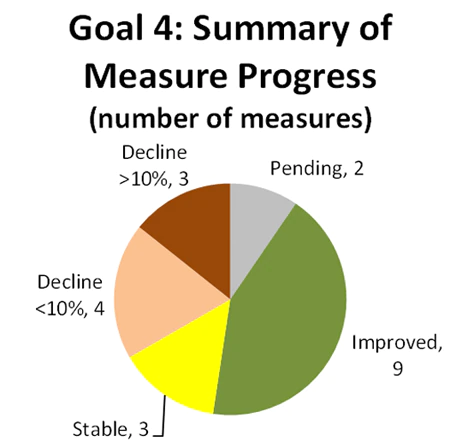As the largest grant-awarding agency in the Federal Government and the nation’s largest health insurer, HHS places a high priority on ensuring the integrity of its expenditures. HHS manages hundreds of programs in basic and applied science, public health, income support, child development, and health and social services, which award over 75,000 grants annually. The Department has robust processes in place to manage the resources and information employed to support programs and activities.
Goal Four includes four objectives:
- Strengthen program integrity and responsible stewardship by reducing improper payments; fighting fraud; and integrating financial, performance, and risk management
- Enhance access to and use of data to improve HHS programs and to support improvements in the health and well-being of the American People
- Invest in the HHS workforce to help meet America’s health and human services needs
- Improve HHS environmental, energy, and economic performance to promote sustainability
HHS University and the VA
HHS University partnered with the Department of Veterans Affairs (VA) to share common training and development requirements for the Department’s medical, science and research practitioners. The technical trainings are in various formats, including web-based, simulations, video, etc. To-date, HHS has acquired 89 trainings from VA for the IHS, CDC, FDA, NIH and HRSA workforces. The Department has realized a total cost avoidance of $7.9M based upon Department of Veterans Affairs’ costs to develop the courses in various formats.
The President’s Now Is the Time initiatives support new activities to expand the behavioral health workforce. In FY 2015, new workforce investments provided support for approximately 3,500 new behavioral health professionals. To ensure that the existing workforce investments would achieve the desired outcomes, SAMHSA workforce activities in FY 2015 included $1.0 million to collaborate with HRSA in the establishment of a Behavioral Health Workforce Research Center. This cooperative agreement supports the conduct of workforce based projects including the development of white papers, data collection and analysis, and targeted research projects on the U.S. Behavioral Health Care Workforce. In FY 2016, SAMHSA is continuing to work with HRSA to expand this research centers impact and to develop clear goals and objectives that meet national behavioral health workforce needs in America.
This Office of Security and Strategic Information, in collaboration with the Office of the Chief Information Officer, established the Cyber Threat Analysis Center (CTAC). The mission and focus of the CTAC is to integrate the technical identification and response capabilities related to cyber intrusions and exfiltrations. This partnership will allow a Department-wide situational awareness of threats and the ability to synthesize and analyze areas of concern stemming from cyber-related activities.
One of CMS’s key goals is to pay Medicare claims properly the first time. This means paying the right amount, to legitimate providers, for covered, reasonable, and necessary services provided to eligible beneficiaries. Paying correctly the first time saves resources required to recover improper payments and ensures the proper expenditure of valuable dollars. The Medicare fee-for-service improper payment rate in FY 2015 was 12.09 percent. The primary cause of improper payments is lack of documentation to support the services or supplies billed to Medicare, or insufficient documentation to determine proper payment. The other causes of improper payments are classified as medical necessity errors and administrative or process errors made by other parties, due to incorrect coding errors. CMS continues to implement corrective actions to address the agency vulnerabilities.
For this goal, 63 percent of measures with available data showed stable or improved performance.


